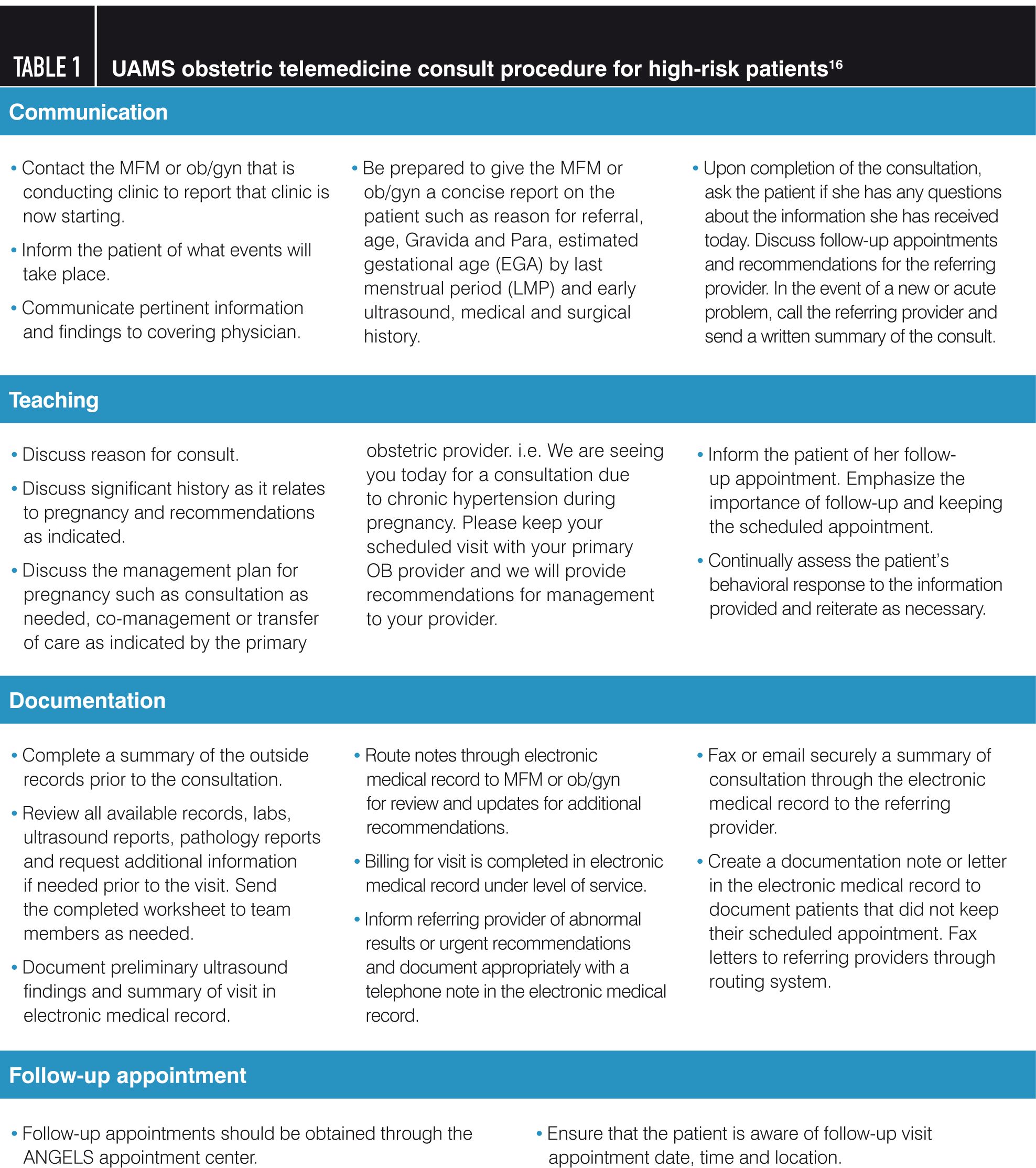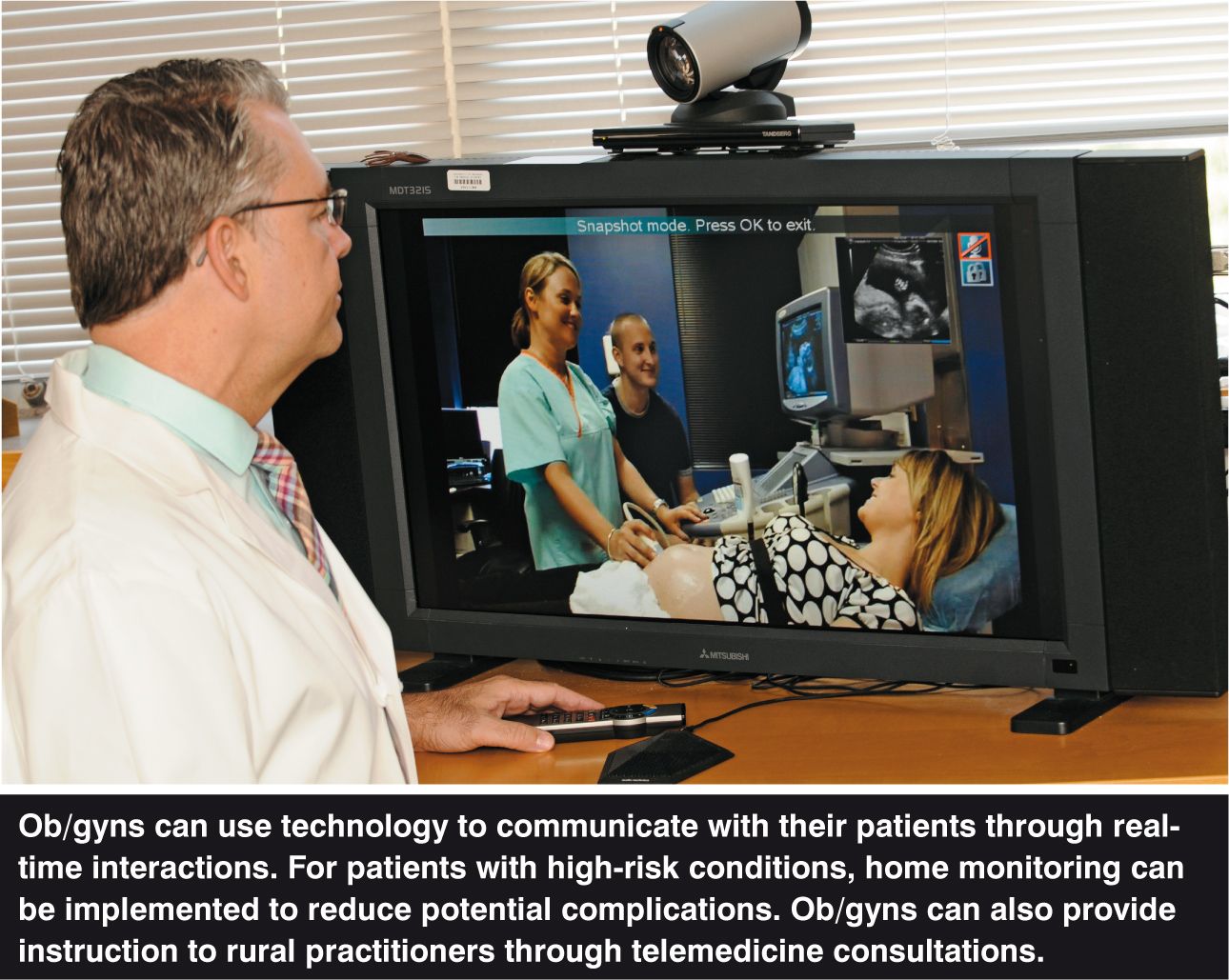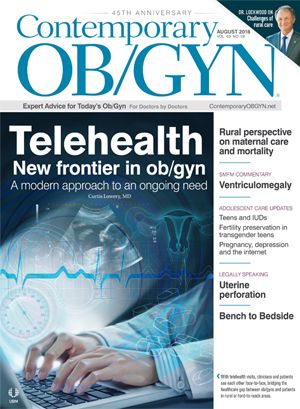Telehealth: A new frontier in ob/gyn
These are the eight steps for successfully launching virtual visits in low- and high-risk obstetrics and gynecology.
Illustration by Alexandra Webber Baker, DNA Illustrations Inc. Click here to see more of her work.

Introduction
Telehealth is a modern-day solution to health problems both old and new. Though it presents benefits to a variety of patients, rural patients likely experience the richest benefits. As Health Resources & Services Administration (HRSA) notes, it can sometimes be difficult to determine whether an area is urban or rural.1 In fact, the term “rural” is not even defined by the Census Bureau-it is considered to encompass “all population, housing, and territory not included within an urban area.” Essentially, according to this definition, whatever is not urban is considered rural. There are two types of urban areas identified by the Census Bureau: 1) Urbanized Areas (UAs) of 50,000 or more people and 2) Urban Clusters (UCs) of at least 2,500 and less than 50,000 people.1Generally, rural areas are characterized by low population and lack of access to critical resources such as medical care.
Rural individuals face many health disparities compared to urban individuals. Poverty and poor access to healthcare contribute greatly to these disparities. Overall, rural communities are in poorer health than others.2 According to the Centers for Disease Control and Prevention, rural Americans are at higher risk of death from five leading causes: heart disease, cancer, unintentional injuries, chronic lower respiratory disease, and stroke.3 In addition, rural areas have higher rates of preterm births and infant mortality.

Telehealth has helped combat these rural disparities through the following four modalities:4
- Live video, which uses audiovisual telecommunications technology;
- Store-and-forward, which involves transmission of health information such as x-rays and other images through a secure electronic communications system to a healthcare provider;
- Remote patient monitoring, which involves electronic transmission of health data from a patient in one location to a provider in another location; and
- Mobile health (mHealth), which includes healthcare and education supported by mobile devices such as tablets and cell phones.
Although there are some barriers to successfully implementing telehealth, it is generally regarded as a convenient and cost-effective way to provide subspecialty healthcare that is not available locally. This is true in obstetrics and gynecology. In obstetrics, telehealth can be used for both low-risk and high-risk pregnancies, and in gynecology, it is used for both routine and specialty examinations.5-8
Telehealth benefits and considerations
Healthcare in America is becoming too expensive for companies, individuals, and taxpayers. Technology offers the potential to offer increased access to care at a better value. In utilizing telehealth, the overall healthcare system benefits from lower costs, less travel, improved health outcomes, and reduced emergency room utilization.9 Although there are numerous benefits to telehealth, there are also many things to consider when beginning or expanding a telehealth program or clinic, including for obstetrics and/or gynecology (see box below).10
Next: Telehealth in low-risk obstetrics
Telehealth in low-risk obstetrics
Although the definition varies, low-risk pregnancies are generally defined as those that can be expected to proceed without major complications. Low-risk pregnant women can benefit from telehealth through routine, at-home appointments with their prenatal providers. Traditionally, even low-risk pregnant patients are seen for numerous in-person obstetrical visits to monitor progress. However, some clinics are offering integrated models of care for these women to save in-person appointments for situations that truly warrant this type of visit, such as for fetal anatomy ultrasounds. Women participating in these virtual visits are given supplies to use at home and are educated regarding how to use the supplies. A typical virtual visit includes the pregnant woman utilizing home monitoring supplies to track measures such as fetal heart rate, maternal blood pressure, and fundal height.11 Pregnancy outcomes have proven to be similar between women who have traditional prenatal care and women who have telemedicine prenatal visits.5 In addition, these virtual visits are associated with time savings and lower visit-related costs for patients,12 something that is a benefit especially to rural patients who must otherwise often travel long distances for obstetrical appointments.

Telehealth in high-risk obstetrics
A pregnant patient at high risk will have current or prior conditions-such as high blood pressure, venous thromboembolism, psychiatric disorder, substance abuse, or family history of a genetic disorder-that may threaten the health or life of the mother or infant.13 Telehealth has helped bring forth improved outcomes for high-risk obstetrics, offering a cost-effective solution to treating patients who are either difficult to transport or have inaccessibility to reliable transportation, a barrier many rural patients face. Within the telemedicine model, rural practitioners will oversee care for high-risk obstetrical patients while receiving direction from a specialist via telemedicine consultation. High-risk prenatal visits take place through videoconferencing between the rural practitioner, the patient, and the specialist, with the specialist at the hub (distant) site and the patient and rural practitioner at the spoke (originating) site. Specialists are able to view ultrasounds and other examinations through the available technology, often in real-time. Home monitoring is also possible for certain high-risk conditions, helping to reduce potentially dangerous travel, identify issues before they threaten the health of the pregnancy, and reduce hospital admissions, when appropriate.
Maternal-fetal medicine (MFM) specialists are crucial to monitoring high-risk pregnancies, as they pursue additional years of training specifically for high-risk pregnancy after completion of their obstetrics-gynecology residency; however, these specialists are often in short supply, especially in rural areas.14 The Medical University of South Carolina (MUSC) Center for Telehealth, a “National Telehealth Center of Excellence,” operates the MUSC Health Maternal Fetal Telemedicine program at six locations throughout South Carolina to address a shortage of MFM providers and high rates of pregnancy conditions such as diabetes and hypertension within many areas of the state.15 As of 2010, over one-third of the state resided in a rural community and thus had a higher likelihood of restricted access to specialty care.16 According to MUSC, “the Maternal Fetal Telemedicine program enables a partnership between MUSC Health’s Maternal Fetal specialists and local providers to co-manage the care and screening of patients with high risk pregnancies and support all the necessary steps to achieve the best possible outcome.” The program has been credited with helping to reduce premature birth rates and both neonatal and maternal mortality rates.15 As many as 50 to 60 MFM telemedicine consultations are performed by MUSC every week, and the program is on call 24/7.14 MUSC additionally uses telemedicine to treat pregnant women addicted to opioids,17 a devastating epidemic.
The University of Arkansas for Medical Sciences (UAMS) also offers a high-risk obstetrical telemedicine program-the Antenatal and Neonatal Guidelines, Education, and Learning System (ANGELS)-to help combat rural health disparities. Arkansas is a largely rural state with vast medically underserved areas. It has few MFM specialists practicing outside of UAMS, which is located in one of the few urban areas of the state. Utilizing one of the largest telehealth networks in the nation, ANGELS extends the expertise of Arkansas’ few board-certified MFM specialists into the hands of Arkansas’ community providers and patients through telemedicine. This allows UAMS providers to plan interventions through a system of co-management with rural providers. ANGELS is supported by a 24/7 nurse-staffed call center that provides triage to patients and facilitates maternal transport to ensure high-risk patients deliver at neonatal intensive care unit-equipped hospitals. The program has been credited with cost savings, reduced infant mortality, and reduced maternal complications. In 2005, the Agency for Healthcare Research and Quality selected ANGELS as one of five Medicaid programs in the United States to serve as models of how to develop patient care and outreach programs. Other organizations use the ANGELS model by working with insurers (like Medicaid and other payors) to develop telemedicine interventions that bring specialty care to those that need it most but have the poorest access. For the UAMS high-risk obstetrical telemedicine program, management of a telemedicine patient consult reflects best practices for patient care (see Table 1 on next page).

Telehealth in gynecology
Patients may benefit from telehealth visits for follow ups to in-person well-woman exams. These virtual visits allow ob/gyns to discuss lab results and needed patient lifestyle changes. In addition, family planning and preconception care can be delivered via telehealth for the patient’s convenience.18 Colposcopy is a specialty exam that is offered through some telemedicine programs to patients who need further testing after an abnormal pap smear. On average, rural areas have fewer practitioners who specialize in colposcopy than urban areas, and fewer ob/gyns in general, so these telehealth services especially benefit rural residents. Diagnostic outcomes were similar for tele-colposcopy when compared with in-person exams.7

Common barriers to telehealth
While telehealth has proven to be an effective method of increasing access to specialty care, there are myriad legal and regulatory issues complicating its expansion. These are issues that affect every clinical application of telemedicine, including obstetrics and gynecology.
Licensing and credentialing
Licensing and credentialing are essential in healthcare but present an especially difficult problem for telehealth providers. Overall, licensing is state-specific for all telemedicine healthcare providers. Moreover, telehealth providers must follow the credentialing rules of the patient’s location. These issues act as barriers to practicing telehealth across state lines. However, hospitals can agree to credential and privilege by proxy for telemedicine services, which allows “the hospital receiving services to accept the distant site (where the telehealth provider is located) hospital’s credentialing and privileging decisions.”19 This would be done in a streamlined and simplified process in comparison to traditional credentialing and licensure, making it easier for providers to offer services across state lines.
Malpractice insurer
Before choosing a malpractice insurer, telemedicine providers should request proof in writing that the malpractice insurance policies cover telemedicine malpractice and that the coverage extends to other states in which the providers are practicing. Telemedicine providers also should check with malpractice insurers to see if there are limitations to telehealth services under the policy. Essentially, providers of telehealth must have total clarification from their insurance company concerning the nuances of telehealth to avoid complications.
Reimbursement and billing
Reimbursement and billing, too, pose a problem for many telehealth providers. In some states, such as Arkansas, telemedicine parity allows for many of these services to be reimbursed on the same basis as in-person services.20 But parity is not available in every state. Even if telemedicine parity laws are active within a state, telemedicine care can be complicated by reimbursement requirements that state rules such as the patient-physician relationship must first be established in person with a face-to-face visit before telemedicine treatment can begin.21 There are some restrictions to payment for services through telemedicine, as well: for example, Arkansas Medicaid will reimburse for up to two live video healthcare visits per patient yearly.20There are also often limitations to services that can be provided through telemedicine, such as prescribing controlled substances. It is therefore important to be aware of state-specific telemedicine laws, especially as they change over time.
Conclusion
Despite telehealth’s barriers, it is an effective healthcare solution for many patients, especially those who are rural. Telehealth programs offer a cost-effective and convenient means to address for women’s obstetrical and gynecological health concerns, leading to improvements such as greater access to care and improved clinical outcomes such as reduced infant and maternal morbidity and mortality. By using best practices and applying lessons learned from telemedicine programs such as those at MUSC and UAMS, other medical institutions can implement successful obstetrical and gynecological telemedicine programs throughout the nation and world.
Disclosures:
The author reports no potential conflicts of interest with regard to this article.
References:
- Defining Rural Population. Health Resources & Services Administration. January 2017.
- Rural Health. Centers for Disease Control and Prevention. https://www.cdc.gov/ruralhealth/about.html. Published August 2, 2017. Accessed June 19, 2018.
- CDC Newsroom. Centers for Disease Control and Prevention. https://www.cdc.gov/media/releases/2017/p0112-rural-death-risk.html. Accessed June 19, 2018.
- What is Telehealth? http://www.cchpca.org/what-is-telehealth. Accessed June 19, 2018.
- Tobah YSB, Leblanc A, Branda M, Inselman J, Gostout B, Famuyide A. OB Nest-A Novel Approach to Prenatal Care [21]. Obstet Gynecol. 2016;127. doi:10.1097/01.aog.0000483637.05137.18.
- Morrison J, Bergauer NK, Jacques D, Coleman SK, Stanziano GJ. Telemedicine: cost-effective management of high-risk pregnancy. Advances in pediatrics. https://www.ncbi.nlm.nih.gov/pubmed/11761593. Published November 2001. Accessed June 19, 2018.
- Etherington IJ. Telecolposcopy - a feasibility study in primary care. Advances in pediatrics. https://www.ncbi.nlm.nih.gov/pubmed/12217121. Published 2002. Accessed June 19, 2018.
- Telemedicine for OB/GYN. Chiron Health. https://chironhealth.com/telemedicine/providers/obstetrics-and-gynecology/. Published 2017. Accessed June 19, 2018.
- Vo A, Brooks GB, Farr R, Raimer B. Benefits of Telemedicine in Remote Communities & Use of Mobile and Wireless Platforms in Healthcare.
- UAMS Center for Distance Health. Arkansas eLink: Starting Your Telemedicine Clinic.
- Mooij MJMD, Hodny RL, Oneil DA, et al. OB Nest: Reimagining Low-Risk Prenatal Care. Mayo Clinic Proceedings. 2018;93(4):458-466.
- Barbour KD, Nelson R, Esplin MS, Varner M, Clark EAS. A randomized trial of prenatal care using telemedicine for low-risk pregnancies: patient-related cost and time savings. January 2017. Supplement to January 2017Am J Obstet Gynecol.
- High-Risk Pregnancy. Eunice Kennedy Shriver National Institute of Child Health and Human Development. https://www.nichd.nih.gov/health/topics/high-risk. Published 2017. Accessed June 19, 2018.
- Fugate E. Decreasing Preterm Birth Rates | Telehealth. MUSC Health. http://www.muschealth.org/pn/2013/yir-2013/telehealth/preterm-birth-rates/index.html. Published March 20, 2015. Accessed June 19, 2018.
- Thomas T. Maternal Fetal Medicine. MUSC Health. http://www.muschealth.org/telehealth/services/community-based/mfm/index.html. Published September 25, 2017. Accessed June 19, 2018.
- South Carolina Urban and Rural Population (1790-2010). South Carolina Statistical Abstract: Population. http://abstract.sc.gov/chapter14/pop30.html. Accessed June 19, 2018.
- Gainer C. Postpartum Mood Disorders Program: MUSC Health Women’s Care. MUSC Health. http://www.muschealth.org/womens/pregnancy/postpartum-mood-disorders/index.html. Published May 7, 2018. Accessed June 19, 2018.
- UAMS Center for Distance Health. ANGELS Program Telemedicine Clinic Policy T-14. June 2016.
- Center for Connected Health Policy. Credentialing and Privileging.
- Arkansas. Search. http://www.cchpca.org/jurisdiction/arkansas?field_area_of_law_tid[] =101&field_law_type_tid=All&field_status_tid=104. Accessed July 13, 2018.
- Arkansas Loosens Telemedicine Restrictions. Center for Telehealth and eHealth Law RSS. http://ctel.org/2016/09/arkansas-loosens-telemedicine-restrictions/. Accessed July 13, 2018.

Study reports US health rankings to plummet by 2050
December 19th 2024Despite modest increases in life expectancy, the United States is set to fall behind globally in health-adjusted life expectancy because of rising obesity rates and other health risks, according to a comprehensive forecast.
Read More
